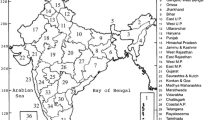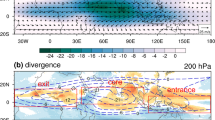Abstract
The atmospheric response, especially the response of the meiyu-baiu rainband, to interannual variability of the sea surface temperature (SST) front associated with the Kuroshio in the East China Sea in early summer is examined by using reanalysis, satellite, and rain-gauge datasets from 1982 to 2010. It is revealed that the strong (weak) SST front in the East China Sea is accompanied by the heavy (weak) precipitation over the central East China Sea and the southern Japan. Because the strong SST front largely results from the negative SST anomaly over the continental shelf, the local evaporation change in the East China Sea is not balanced by this enhanced precipitation. The moisture for this enhanced precipitation is supplied by interannual variability of horizontal wind convergence over the central East China Sea. In addition to the precipitation change, the strong SST front is also accompanied by the intensification of weather disturbances in the lower troposphere over the East China Sea. This is probably because the negative SST anomaly over the continental shelf enhances the baroclinicity in the lower troposphere. This intensification of the weather disturbances over the East China Sea can explain the enhanced precipitation over the central East China Sea in response to the interannual variability of the SST front. Because the SST anomaly over the continental shelf, which primarily determines the interannual variability of the SST front, persists for a couple of months, these results imply the predictability of the precipitation associated with the meiyu-baiu rainband.














Similar content being viewed by others
References
Akiyama T (1975) Southerly transversal moisture flux into the extremely heavy rainfall zone in the Baiu Season. J Meteorol Soc Jpn Ser II 53:304–316. https://doi.org/10.2151/jmsj1965.53.5_304
Alexander MA, Lau N-C, Scott JD (2004) Broadening the atmospheric bridge paradigm: ENSO teleconnections to the Tropical West Pacific-Indian Oceans over the seasonal cycle and to the North Pacific in summer. earth’s climate. American Geophysical Union, pp 85–103. https://doi.org/10.1029/147GM05
Chang C-P, Hou SC, Kuo HC, Chen GTJ (1998) The development of an intense East Asian Summer Monsoon disturbance with strong vertical coupling. Mon Wea Rev 126:2692–2712
Chelton DB, Schlax MG, Freilich MH, Milliff RF (2004) Satellite measurements reveal persistent small-scale features in ocean winds. Science 303:978–983. https://doi.org/10.1126/science.1091901
Du Y, Li T, Xie Z, Zhu Z (2016) Interannual variability of the Asian subtropical westerly jet in boreal summer and associated with circulation and SST anomalies. Clim Dyn 46:2673–2688. https://doi.org/10.1007/s00382-015-2723-x
Frankignoul C, Sennéchael N, Kwon Y-O, Alexander MA (2011) Influence of the meridional shifts of the Kuroshio and the Oyashio extensions on the atmospheric circulation. J Clim 24:762–777
Fujibe F (2015) Relationship between interannual variations of extreme hourly precipitation and air/sea-surface temperature in Japan. SOLA 11:5–9. https://doi.org/10.2151/sola.2015-002
Hand R, Keenlyside N, Omrani N-E, Latif M (2014) Simulated response to inter-annual SST variations in the Gulf Stream region. Clim Dyn 42:715–731
Hoskins BJ, Valdes PJ (1990) On the existence of storm-tracks. J Atmos Sci 47:1854–1864
Huffman GJ et al (2007) The TRMM multisatellite precipitation analysis (TMPA): quasi-global, multiyear, combined-sensor precipitation estimates at fine scales. J Hydrometeorol 8:38–55. https://doi.org/10.1175/JHM560.1
Iizuka S (2010) Simulations of wintertime precipitation in the vicinity of Japan: Sensitivity to fine-scale distributions of sea surface temperature. J Geophys Res Atmos 115:D10107. https://doi.org/10.1029/2009jd012576
Isobe A, Kako S (2012) A role of the Yellow and East China Seas in the development of extratropical cyclones in winter. J Clim 25:8328–8340
Joyce TM, Kwon Y-O, Yu L (2009) On the relationship between synoptic wintertime atmospheric variability and path shifts in the Gulf Stream and the Kuroshio extension. J Clim 22:3177–3192. https://doi.org/10.1175/2008jcli2690.1
Kako S, Nakagawa T, Takayama K, Hirose N, Isobe A (2016) Impact of Changjiang River discharge on sea surface temperature in the East China Sea. J Phys Oceanogr 46:1735–1750 doi. https://doi.org/10.1175/JPO-D-15-0167.1
Kamiguchi K, Arakawa O, Kitoh A, Yatagai A, Hamada A, Yasutomi N (2010) Development of APHRO_JP, the first Japanese high-resolution daily precipitation product for more than 100 years. Hydrol Res Lett 4:60–64
Kato T (1998) Numerical simulation of the band-shaped torrential rain observed over southern Kyushu, Japan on 1 August 1993. J Meteorol Soc Jpn 76:97–128
Kawai Y, Moteki Q, Kuwano-Yoshida A, Enomoto T, Manda A, Nakamura H (2017) Impact Propagation of Radiosonde data assimilation over the Kuroshio and Kuroshio extension: case study on the early Summer (Baiu) in 2012. J Meteorol Soc Jpn 95:71–90. https://doi.org/10.2151/jmsj.2017-004
Kawase H et al (2009) Intermodel variability of future changes in the Baiu rainband estimated by the pseudo global warming downscaling method. J Geophys Res Atmos 114:D24110. https://doi.org/10.1029/2009JD011803
Kelly KA, Small RJ, Samelson RM, Qiu B, Joyce TM, Kwon Y-O, Cronin MF (2010) Western boundary currents and frontal air–sea interaction: Gulf Stream and Kuroshio extension. J Clim 23:5644–5667. https://doi.org/10.1175/2010jcli3346.1
Kida S et al (2015) Oceanic fronts and jets around Japan: a review. J Oceanogr 71:469–497. https://doi.org/10.1007/s10872-015-0283-7
Kwon M, Jhun J-G, Wang B, An S-I, Kug J-S (2005) Decadal change in relationship between east Asian and WNP summer monsoons. Geophys Res Lett 32:L16709. https://doi.org/10.1029/2005GL023026
Liu WT, Xie X, Niiler PP (2007) Ocean–Atmosphere Interaction over Agulhas Extension Meanders. J Clim 20:5784–5797. https://doi.org/10.1175/2007jcli1732.1
Liu J-W, Xie S-P, Yang S, Zhang S-P (2016) Low-cloud transitions across the Kuroshio Front in the East China Sea. J Clim 29:4429–4443
Ma X et al (2017) Importance of resolving Kuroshio Front and Eddy influence in simulating the North Pacific Storm Track. J Clim 30:1861–1880
Manda A et al. (2014) Impacts of a warming marginal sea on torrential rainfall organized under the Asian summer monsoon. Sci Rep 4 https://doi.org/10.1038/srep05741
Masunaga R, Nakamura H, Miyasaka T, Nishii K, Tanimoto Y (2015) Separation of climatological imprints of the Kuroshio Extension and Oyashio fronts on the wintertime atmospheric boundary layer: their sensitivity to SST resolution prescribed for atmospheric reanalysis. J Clim 28:1764–1787
Maximenko N et al (2009) Mean dynamic topography of the ocean derived from satellite and drifting buoy data using three different techniques. J Atmos Ocean Technol 26:1910–1919
Minobe S, Kuwano-Yoshida A, Komori N, Xie SP, Small RJ (2008) Influence of the Gulf Stream on the troposphere. Nature 452:206–209. https://doi.org/10.1038/nature06690
Minobe S, Miyashita M, Kuwano-Yoshida A, Tokinaga H, Xie S-P (2010) Atmospheric response to the Gulf Stream: seasonal variations. J Clim 23:3699–3719
Nakamura M, Yamane S (2010) Dominant anomaly patterns in the near-surface Baroclinicity and accompanying anomalies in the atmosphere and oceans. Part II: North Pacific Basin. J Clim 23:6445–6467. https://doi.org/10.1175/2010jcli3017.1
Nakamura H, Sampe T, Goto A, Ohfuchi W, Xie S-P (2008) On the importance of midlatitude oceanic frontal zones for the mean state and dominant variability in the tropospheric circulation. Geophys Res Lett 35. https://doi.org/10.1029/2008gl034010
Nakamura H, Nishina A, Minobe S (2012) Response of storm tracks to bimodal Kuroshio path states south of Japan. J Clim 25:7772–7779
Ninomiya K (1984) Characteristics of Baiu front as a predominant sub-tropical front in the summer northern hemisphere. J Meteorol Soc Jpn 62:880–894
Ninomiya K, Shibagaki Y (2003) Cloud system families in the Meiyu-Baiu front observed during 1–10 July 1991. J Meteorol Soc Jpn 81:193–209
O’Neill LW, Esbensen SK, Thum N, Samelson RM, Chelton DB (2010) Dynamical analysis of the boundary layer and surface wind responses to mesoscale SST perturbations. J Clim 23:559–581
O’Reilly CH, Czaja A (2014) The response of the Pacific storm track and atmospheric circulation to Kuroshio Extension variability. Q J R Meteorol Soc. https://doi.org/10.1002/qj.2334 (in press)
Ogata T, Johnson SJ, Schiemann R, Demory M-E, Mizuta R, Yoshida K, Arakawa O (2017) The resolution sensitivity of the Asian summer monsoon and its inter-model comparison between MRI-AGCM and MetUM. Clim Dyn 1–17
Parfitt R, Czaja A, Minobe S, Kuwano-Yoshida A (2016) The atmospheric frontal response to SST perturbations in the Gulf Stream region. Geophys Res Lett 43:2016GL067723. https://doi.org/10.1002/2016GL067723
Reynolds RW, Smith TM, Liu C, Chelton DB, Casey KS, Schlax MG (2007) Daily high-resolution-blended analyses for sea surface temperature. J Clim 20:5473–5496
Saha S et al (2010) The NCEP climate forecast system reanalysis. Bull Am Meteor Soc 91:1015–1057. https://doi.org/10.1175/2010bams3001.1
Sampe T, Xie S-P (2010) Large-scale dynamics of the Meiyu-Baiu rainband: environmental forcing by the westerly jet. J Clim 23:113–134
Sasaki YN, Minobe S, Asai T, Inatsu M (2012) Influence of the Kuroshio in the East China Sea on the Early Summer (Baiu) Rain. J Clim 25:6627–6645
Shibagaki Y, Ninomiya K (2005) Multi-scale interaction processes associated with development of a sub-synoptic-scale depression on the Meiyu-Baiu frontal zone. J Meteorol Soc Jpn 83:219–236. https://doi.org/10.2151/jmsj.83.219
Small RJ et al (2008) Air–sea interaction over ocean fronts and eddies. Dyn Atmos Oceans 45:274–319. https://doi.org/10.1016/j.dynatmoce.2008.01.001
Small RJ, Tomas RA, Bryan FO (2014) Storm track response to ocean fronts in a global high-resolution climate model. Clim Dyn 43:805–828
Smith BL, Yuter SE, Neiman PJ, Kingsmill DE (2010) Water vapor fluxes and orographic precipitation over Northern California associated with a landfalling atmospheric river. Mon Wea Rev 138:74–100. https://doi.org/10.1175/2009mwr2939.1
Taguchi B, Nakamura H, Nonaka M, Komori N, Kuwano-Yoshida A, Takaya K, Goto A (2012) Seasonal evolutions of atmospheric response to decadal SST anomalies in the North Pacific Subarctic frontal zone: observations and a coupled model simulation. J Clim 25:111–139. https://doi.org/10.1175/JCLI-D-11-00046.1
Tochimoto E, Kawano T (2012) Development processes of Baiu frontal depressions. SOLA 8:9–12. https://doi.org/10.2151/sola.2012-003
Tokinaga H, Tanimoto Y, Xie S-P, Sampe T, Tomita H, Ichikawa H (2009) Ocean frontal effects on the vertical development of clouds over the Western North Pacific: in situ and satellite observations. J Clim 22:4241–4260
Tomita H, Kubota M, Cronin MF, Iwasaki S, Konda M, Ichikawa H (2010a) An assessment of surface heat fluxes from J-OFURO2 at the KEO and JKEO sites. J Geophys Res 115. https://doi.org/10.1029/2009jc005545
Tomita T, Nonaka M, Yamaura T (2010b) Interannual variability in the subseasonal northward excursion of the Baiu front. Int J Climatol 30:2205–2216
Tsunematsu N, Dairaku K, Hirano J (2013) Future changes in summertime precipitation amounts associated with topography in the Japanese islands. J Geophys Res Atmos 118:4142–4153. https://doi.org/10.1002/jgrd.50383
Wu L et al (2012) Enhanced warming over the global subtropical western boundary currents. Nat Clim Chang 2:161–166. https://doi.org/10.1038/nclimate1353
Xie S-P, Hafner J, Tanimoto Y, Liu WT, Tokinaga H, Xu H (2002) Bathymetric effect on the winter sea surface temperature and climate of the Yellow and East China Seas. Geophys Res Lett 29:2228. https://doi.org/10.1029/2002GL015884
Xu H, Xu M, Xie S-P, Wang Y (2011) Deep atmospheric response to the spring Kuroshio over the East China Sea. J Clim 24:4959–4972
Xu M, Xu H, Ren H (2017) Influence of Kuroshio SST front in the East China Sea on the climatological evolution of Meiyu rainband. Clim Dyn. https://doi.org/10.1007/s00382-017-3681-2
Yang J, Liu Q, Xie S-P, Liu Z, Wu L (2007) Impact of the Indian Ocean SST basin mode on the Asian summer monsoon. Geophys Res Lett 34:L02708
Yang H, Lohmann G, Wei W, Dima M, Ionita M, Liu J (2016) Intensification and poleward shift of subtropical western boundary currents in a warming climate. J Geophys Res-Oceans 121:4928–4945. https://doi.org/10.1002/2015JC011513
Yim SY, Wang B, Xing W, Lu MM (2015) Prediction of Meiyu rainfall in Taiwan by multi-lead physical-empirical models. Clim Dyn 44:3033–3042
Yu L, Jin X, Weller RA (2008) Multidecade Global Flux Datasets from the Objectively Analyzed Air-sea Fluxes (OAFlux) Project: Latent and sensible heat fluxes, ocean evaporation, and related surface meteorological variables. Woods Hole Oceanographic Institution, OAFlux Project Technical Report. OA-2008–01, p 64. Woods Hole Massachusetts
Acknowledgements
We thank Profs. S. Minobe and M. Inatsu for valuable comments. We also thank three anonymous reviewers for their constructive comments on the manuscript. This research was supported by the Grant-in-Aid for Young Scientists (B) Grant no. 16K1780, which is funded by the Ministry of Education, Culture, Sports, Science, and Technology of Japan. The TRMM3A25 data were provided by the NASA/Goddard Space Flight Center.
Author information
Authors and Affiliations
Corresponding author
Rights and permissions
About this article
Cite this article
Sasaki, Y.N., Yamada, Y. Atmospheric response to interannual variability of sea surface temperature front in the East China Sea in early summer. Clim Dyn 51, 2509–2522 (2018). https://doi.org/10.1007/s00382-017-4025-y
Received:
Accepted:
Published:
Issue Date:
DOI: https://doi.org/10.1007/s00382-017-4025-y




